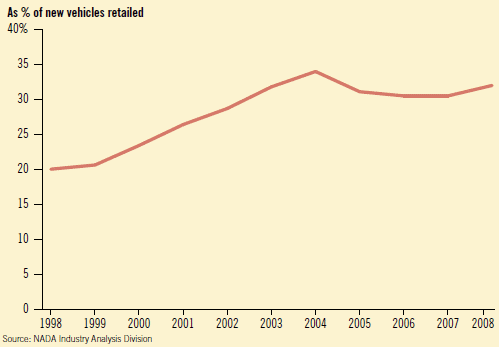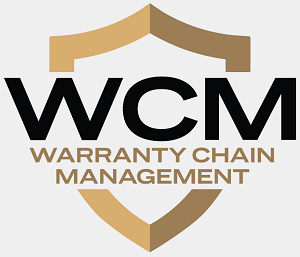Vehicle Service Contract
Attachment Rates:
Has the chaos of the Great Recession actually increased the appeal of vehicle service contracts? Auto dealers aren't selling as many as they used to, but for at least the past five years roughly one out of every three customers has bought one. And the recent trend seems to have been upwards, as unlikely as that sounds.
As we continue our tour of the vehicle service contract industry, we're on the lookout for statistical data and numerical trends that can be welded into an economic model of the industry.
Granted, the mischief of the "expired warranty" people has poisoned the well for the direct marketers who try to sell service contracts over the phone, by mail, or on the Internet. But the dealer channel has always been a much more dependable source of sales, with service contracts typically purchased by around one-third of new car buyers.
The problem is that far fewer people are buying new cars, thanks to the effects of the Great Recession. And one-third of ten million is a lot smaller than one-third of sixteen million. So even if the attachment rate has stayed the same, the totals have fallen. But the amazing thing is that the attachment rates seem to have stayed the same.
The National Automobile Dealers Association documents the dealer channel extensively, issuing an annual report called "NADA Data" that contains statistics for virtually anything one could imagine. We're still a few weeks shy of the 2010 release (covering calendar 2009), but the 2009 edition is available on the group's web site.
Documenting Dealer Trends
NADA's Industry Analysis Division, which puts the annual reports together, counted 20,010 new car dealerships in 2009, down significantly from 22,400 in 1999. And the reason for that consolidation isn't hard to find. According to the NADA data, in 2008 the typical auto dealer had before-tax profits of $280,000 on sales of $28.8 million. That's only a 1.0% profit margin, and it's down by almost half from 2007's before-tax profit margin of 1.5%.
NADA said these dealers together performed $12.6 billion in warranty work in 2008, of which 56% was for parts and 44% was for labor. Warranty work was a little over 15% of the typical dealer's total service and parts operation. And despite recent increases in product reliability, service and parts produced a more dependable revenue stream than new car sales. As of June 2009, new car sales were down by almost 30% from their year-before pace, but service and parts revenue was down by only 1.3% over the same period.
The chart that caught our eye, however, was one on page 8 that tracks vehicle service contract attachment rates from 1998 to 2008. The chart, which we reproduce below, shows a 1998 market in which roughly 20% of new car sales transactions included a service contract, and steady growth to a 2004 market that shows a penetration rate closer to 35%.
Vehicle Service Contract Sales
Franchised Dealer Attachment Rates
1998-2008

All the while, annual car sales volumes remained close to sixteen million units. This means that as the penetration rate for vehicle service contracts rose from roughly one-in-five to one-in-three, the number of service contracts sold by franchised dealers rose from 3.1 million to 5.7 million per year.
In the years since 2004, the attachment rate has dipped back down to around 30%, but in 2008 it took an ever-so-tentative turn upwards once more. And that leads to an important question: Has the chaos of the Great Recession actually increased the appeal of vehicle service contracts? Have the bankruptcies of Chrysler and General Motors raised the value of peace of mind?
One Year Is Not a Trend
Paul Taylor, the chief economist in NADA�s Industry Analysis Division, cautioned us not to read too much into this tiny upturn. "It's modest, and it's only a trend of one year," he said. "Generally, you need a couple of years to see whether something is a change in the long-term trend or just an aberration from the ongoing long-term trend."
In case the chart is hard to eyeball, the 2008 data point is 32.1%. And let's be realistic. This isn't a big change, as Taylor cautioned. The biggest change in the data in the past few years has come in the number of new cars sold by U.S.-based dealers. That total fell from 16.1 million passenger cars and light trucks sold in 2007 to only 13.2 million sold in 2008 and a paltry 10.4 million sold in 2009. And that's the first time sales have ever fallen for two years in a row.
So does that mean the people who actually did go out and buy a new car were slightly more likely to buy a service contract than the people who stayed home? Or will the 2009 data show a big drop, as those who did go shopping looked for the lowest possible price with the least amount of protection?
"One thing that we think would cause a greater adoption rate of service contracts is general economic concern during a recession," Taylor said. "That's consistent with people being risk-averse in a recessionary situation."
But it's not the only possible factor. In fact, one could argue that the people who decided not to buy -- those who would have bought one of the six million vehicles that weren't sold -- were the most risk-averse of all. They stayed home and bought neither a car nor a service contract.
Plenty of Reasons Not To Buy
And even among those who did buy a new car during the Great Recession, the extra cost of a service contract would theoretically be easier to decline. Anything that adds cost to the transaction is less appealing when financing is tight and fear levels are elevated. Therefore, if anything, the attachment rate should have fallen in 2008 -- not risen.
Then again, perhaps since there were less prospects on the selling floor, it was easier for the salespeople to spend more time per customer, making it possible for them to explain the benefits of service contracts more fully? Or are there additional factors?
"Another clear incentive to have a service contract is the added complexity of some of the vehicles, particularly the hybrid vehicles," Taylor suggested. "But increasing complexity extends beyond hybrids. Typical cars are more complex as well. Over the course of the last 15 years, the level of standard equipment that's considered normal for a car has increased dramatically. There are telematics in cars that there weren't 15 years ago. There are electric windows, automatic starting, electronic locking, satellite radio, the use of chips in engine control and in transmission control, and in enhancing fuel mileage."
Taylor added that he's just not yet sure whether any of these factors are actually responsible for producing the recent upturn in the attachment rate. There could be another explanation. Perhaps the increasing complexity drove up the attachment rate from 1998 to 2004, and the economic protection/peace of mind argument kept it high ever since?
"It's a complex question," Taylor said. "But concern about general economic shocks is in there. If you're worried about losing your job you don't want to have to spend $4,000 on a repair on your car." So you sell the risk by purchasing a service contract. In uncertain times, the value of peace of mind rises.
Sales Skills?
Then again, we're still talking about roughly one-in-three customers buying a service contract. That hasn't changed much in five years, when dealers sold 60% more new cars than they did in 2009. Maybe it has less to do with the economy and more to do with the skills of the seller?
Neville Flintoft, F&I Manager at Bill Luke Chrysler Jeep & Dodge in Phoenix, said he thinks it depends upon the individual, and that there as many forces driving up service contract sales as there are driving them down.
"So it's probably a bit of a wash," he said. "Some people feel it's more important than ever now to get a service contract, because of the fact that this might be the only car they buy for a while." And some people decide to take their chances, and to go without one.
Phoenix has been extremely hard-hit by the Great Recession, with an epidemic of foreclosures driving cutbacks at all levels. Some people might be buying cars they can barely afford, so they might not want to risk the added cost of repairs in the future. Others might be buying cars they can barely afford, and they would rather put off to the hopefully distant future any thoughts of repair bills.
"Trying to convince a customer that they need to protect themselves from something in the future is a lot tougher today that it was a few years ago," Flintoft said. And that would cause attachment rates to fall. So why haven't they?
High Attachment Rate Remains High
Bottom line, Flintoft said he's seen fewer customers overall, but there's been no change in the attachment rate, which for his dealership stands at an unusually high 45%. And that, he said, is a testament to the skills of the dealership's sales force.
"We have a high level of experience in the finance department," Flintoft said. "The three gentlemen I work with that sell service contracts are seasoned veterans of the automobile industry. We spent money training them, making sure they know all the objections and how they can overcome all the objections that customers may have."
Eric Maerker, founder and president of Warranty Risk Services LLC, also suggested that it has more to do with who is doing the selling. "A quality F&I manager will sell it," he said. "I don't think that the economy is the driving force. I don't think there is a correlation."
Instead, Maerker pointed to factors such as the increasingly standardized presentation and menu-oriented sales process adopted by many dealerships. Ironically, many worried that if the sales force had to follow a script, they'd lose that edge that makes it possible for them to keep attachment rates high in good times or bad.
"Everybody used to think that it was exclusively the talent of the salesmen," Maerker said. "But when the salesmen at some of the larger dealer groups were required to use a menu to present to the customer -- and they created some very attractive graphics to go with it -- it would show the customer that if you buy the car with no protection, this is what your monthly payment will be. And it had a stair step. If you get all of the protection, your payment will be this. And if you get just the service contract, your payment is right here."
This process, which one would think was too rigid and mechanized to allow the salesmen to practice the art of selling, actually caused service contract attachment rates to rise, Maerker said. "They actually got better penetration through using the menus," he said. "The graphic would normally have four different payments, depending on the level of protection that the customer wanted, with other add-on features such as tire and wheel protection. So when customers could focus on picking one of these four, it seemed to stop the choice of whether they wanted a particular product."
However, all of this assumes that customers are financing their purchase in the business office. Only during that discussion with the finance and insurance department does it become possible to turn the four-figure price tag of the service contract into a two-digit monthly payment over the life of the loan. Which sounds better: $1,500 now or $25 a month for 60 months?
Self-Insuring the Risk
That choice, of course, assumes that the customer's credit score will be high enough to qualify for the higher monthly payment. And if they're paying cash, they're not even likely to want to hear about all those different add-ons. If they can afford to pay cash for a new vehicle, with average prices close to $29,000 per unit, they're more likely to want to self-insure the risk of repair expenses.
Or are they? Vehicle complexity is rising, repair costs are rising, and the prospect of customer self-repair is becoming less and less likely. So perhaps even those who can afford to go without a service contract are finding technological reasons to buy one anyway?
Then again, with three-year warranties becoming more or less standard, it's highly possible that customers who can afford to buy a new vehicle every few years will always be able to avoid the risk of having to pay for repairs by never being out of warranty. In other words, who needs a four- or five-year service contract if they're only going to own the car for three years?
Longer Warranties Impact Service Contracts?
Maerker said that seems to be another one of those trends that sounds good in theory but hasn't proven itself in fact. "Over the years, I think it has confounded folks in the industry that as the warranty on the vehicle got longer and longer, the attachment rate seemed to stay the same," he said.
Maerker got his start in the industry at a time when 12 months or 12,000 miles was the standard new car warranty. Then it lengthened to three or four years, then seven, ten, and even lifetime warranties came to market for a brief period. But it didn't seem to hurt sales of service contracts.
"It's more about how you sell and who is selling in the business office than the underlying warranty, or the economy, or anything else," Maerker added. "A good selling system will achieve the sale. And where that's weak, it won't be sold."










